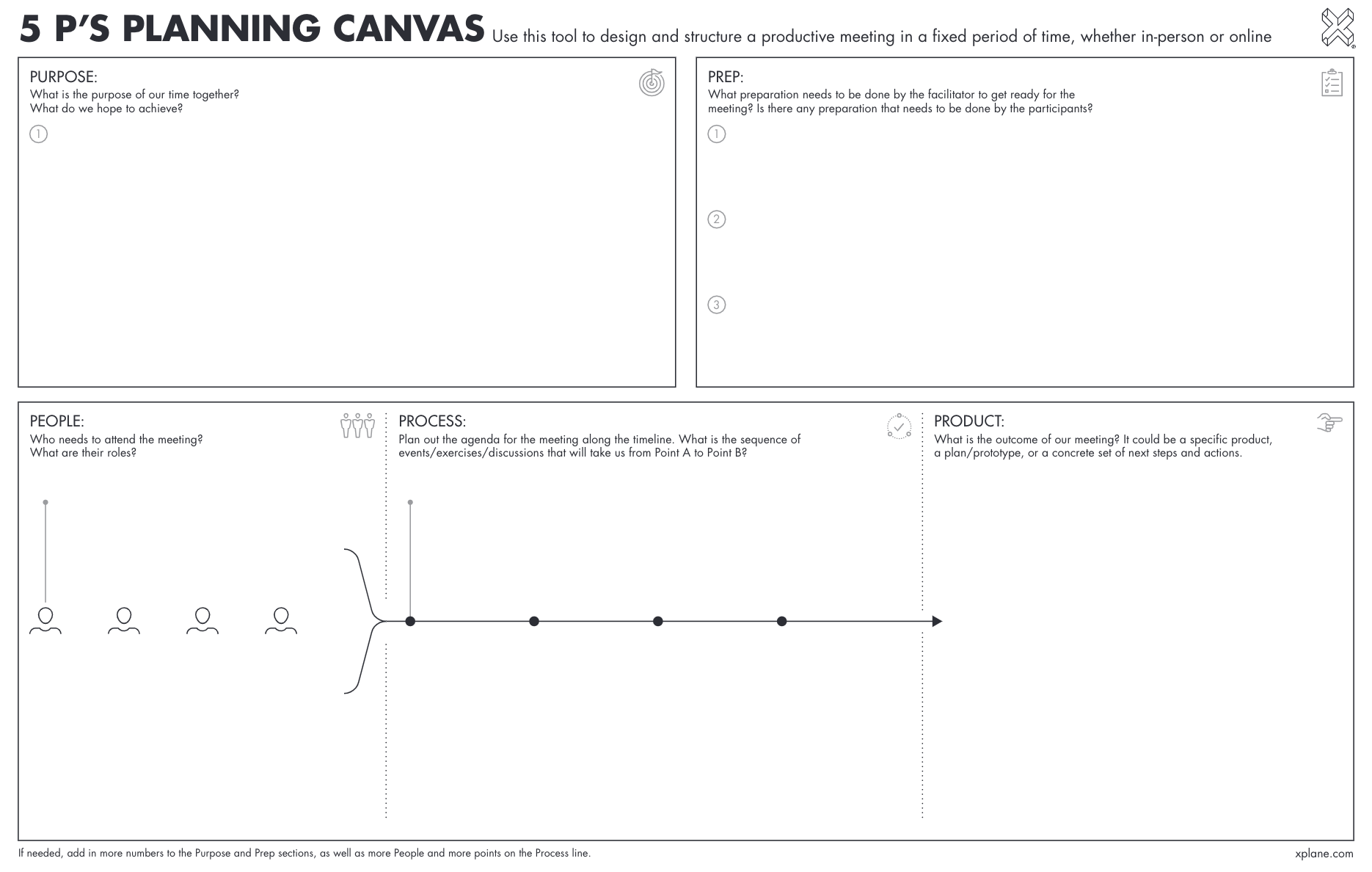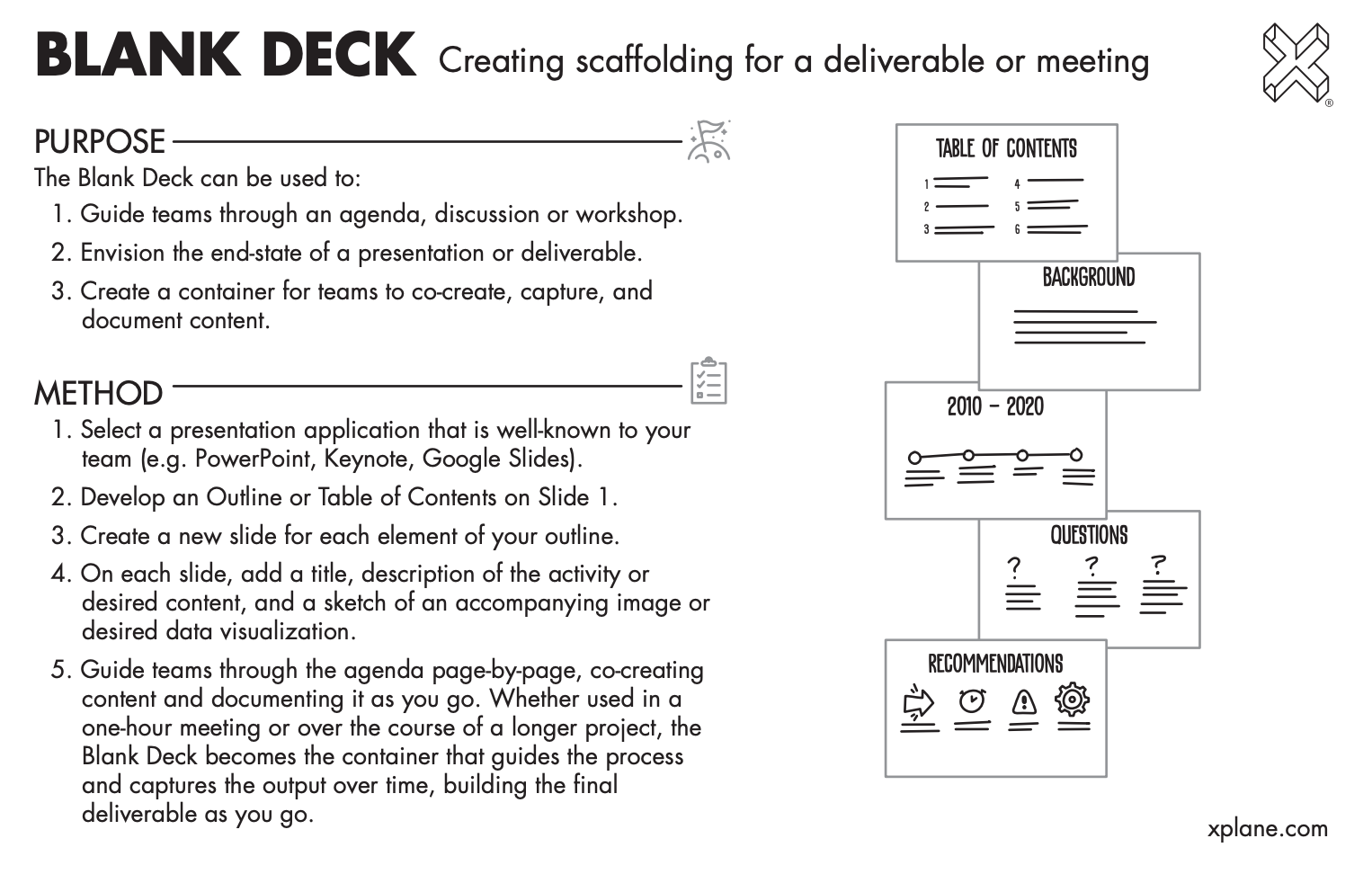The rise of COVID-19 (coronavirus) has made remote collaboration an overnight necessity for many companies.
As a firm that works with globally distributed teams, XPLANE has amassed a number of best practices for leading effective online meetings—skills that we’ve honed over the last many years.
While you can’t replicate every element of an in-person meeting online (think energy!), online meetings can be highly effective if properly designed and facilitated.
Here are our top 25 tips and tricks, curated from a panel of XPLANE consultants who use them every day.
Tools and platforms: What are our go-to tools for connecting people online?
- MURAL is our preferred digital workspace. Think of this as your online conference room. You can leverage its built-in whiteboard, sticky notes, diagramming, commenting, and collaboration tools to replicate (and in some cases, enhance) the work you would do in a live meeting.
- Zoom is our preferred video, audio, and chat solution for our meetings. Think of this as the “connective tissue” that brings everyone together in an easy-to-use, stable platform. We pair Zoom with the other solutions recommended here.
- Google Docs is our preferred application for creating documents and spreadsheets simply because documents created in Google Docs work so effectively as online collaborative artifacts. Everyone can edit and work together in real time, and documents live on for continued edits (and built-in version control) beyond the meeting.
Agenda and canvases: How do we create structure in online meetings?
 The “5 P’s canvas”—purpose, people, prep, process, and product—is how we plan our meetings, online and off. We believe planning these in advance will make your meeting twice as effective in half the time.
The “5 P’s canvas”—purpose, people, prep, process, and product—is how we plan our meetings, online and off. We believe planning these in advance will make your meeting twice as effective in half the time.
![]() The “initiative tracker canvas” is a tool to plan, track, and communicate progress on initiatives. A simple one-pager, it works well in online formats.
The “initiative tracker canvas” is a tool to plan, track, and communicate progress on initiatives. A simple one-pager, it works well in online formats.
 The “blank deck” is a great way to put scaffolding into your online meeting. Very simply, using your preferred presentation application, you build out each of your agenda items into its own page and then scroll through the pages one at a time to move the meeting forward and capture content as you go. It helps participants follow the path, provides a way to capture content, and drives the meeting forward.
The “blank deck” is a great way to put scaffolding into your online meeting. Very simply, using your preferred presentation application, you build out each of your agenda items into its own page and then scroll through the pages one at a time to move the meeting forward and capture content as you go. It helps participants follow the path, provides a way to capture content, and drives the meeting forward.
Meeting preparation: How does online meeting preparation differ?
- Add prep time. Online meeting design takes longer. You need to plan more thoroughly to ensure that the meeting will be productive. Tools, canvases, and technology must be set up in advance. We assume 30–60 minutes of prep at a minimum.
- Have both a scribe and a facilitator. Leading an online meeting is like being an MC of a production. In addition to leading the agenda, there are also connectivity issues, chat windows, document management, and other considerations to manage. If one person is assigned to be the scribe (documenting the meeting, managing the document handling and chat windows, etc.), the facilitator is freed to focus on successfully driving the agenda and ensuring each participant is included and heard.
- Plan a 5- to 10-minute tutorial at the start of the meeting. Don’t assume all participants know how to use the online tools—because they won’t. Use the opening moments of the meeting to highlight any tools or functions that you want participants to use, so when the time comes to solicit contributions in the chat window or to complete a poll, you don’t use precious minutes disrupting the flow of the meeting to conduct IT support.
- Pro tip: If you plan to standardize any tools among your team, lead a separate “online meeting tools” onboarding session for employees prior to your standing meetings.
- Plan for backup audio. Live video requires a lot of bandwidth, and sometimes home offices aren’t as well equipped as your usual workplace. Have a backup audio channel and call-in information ready for anyone struggling to connect, and add the dial-in info to the front of your online welcome page and within the invitation itself.
Etiquette: What norms should be established for online meetings?
- Everyone on video. If your meeting is video-enabled, have everyone turn their camera on—even if some participants are together in a conference room. This is a best practice for two reasons: First, it levels the playing field. Everyone is on-screen, seeing one another, and remote participants don’t get left behind if those in a conference room revert to traditional face-to-face interaction. Secondly, and most important, 50% to 90% of communication is nonverbal. While we can’t (yet) replicate the energy of an in-person meeting, we can improve it dramatically by being able to see each other.
- Mute when not speaking. Remote work often comes with some additional distractions—dogs barking, children crying, construction next door. Encourage people to participate actively on the call but to mute their speakers when they’re not talking.
- Actively invite participation. Remember that silence does not mean agreement, nor does silence indicate active participation. Make a point to periodically ask silent participants what they have to add, to ensure all voices are heard and people stay engaged.
- Echo and amplify. Another tip for facilitators—especially when part of the group is gathered together, and some individuals are online: Remember that much of what’s said in the conference room isn’t heard by the distributed (remote) participants. Be mindful of this by “echoing and amplifying” key points said in the room. Restate questions asked, highlight decisions made, and paraphrase insightful comments so all participants have the same information.
- Invoke the “be present” rule. Have participants close all other apps and open windows (or use a program blocker) so you and your team are not distracted by other work and interruptions (or embarrassing messages!) that might pop up.
Bonuses: What benefits come with the shift to online?
There are some very real benefits to shifting meetings online. You can take advantage of the new opportunities online platforms create:
- Standing workroom. You know that thing, where the walls are covered with stickies and the whiteboard is covered with sketches, but you need to clear the room for the next meeting? Never again. Platforms like MURAL allow you to create a workroom with content stored in a perpetual space, ready for your team the next time you convene.
- Asynchronous collaboration. Time zone differences can make distributed meetings challenging. Online tools like those mentioned above allow people to contribute to workspaces, canvases, and documents on a rolling basis, even if they can’t attend a meeting.
- Recording and transcription. Another benefit for distributed teams: If you miss a meeting, it can be easily recorded, and even transcribed.
- Chat room. This feature gives facilitators a lot of latitude in engaging people in brainstorming, asking and answering questions, or simply moving a “sideline” conversation into an interactive “parking lot.”
- Polling and dot-voting. These features allow facilitators to get nearly instant feedback on ideas or to prioritize a set of options.
- Pro tip: You can set these features to “anonymous” to allow more authentic participation from shy voices in the room.
- Instant document sharing. Unlike a live meeting, reference materials (images, documents, workplans, presentations, etc.) can be quickly called up, shared, and even compared side-by-side on participants’ desktops.
- Fast feedback. Collaborative platforms allow participants to sort and affinity-map sticky notes quickly and simultaneously, and collaboratively and instantly mark up documents.
- Endless whiteboard. If you’re like us at XPLANE, you often run out of whiteboard in particularly productive live sessions. Online canvases can be extended infinitely and even broken into sections and chapters for easy navigation.
- Time, cost, and environmental impact. Gathering people together in one room is expensive, especially if travel is required. Increasing the percentage of meetings held online will save time, expense, and the environmental impact of travel.
- Safety. Online meetings are not just a workaround for a rescheduled live session—they contribute to the health and safety of employees and participants in times of crisis, whether the risk be viral, political, or otherwise.
While we as business leaders need to be proactive and prepared in times of challenge, we can still ensure our teams are engaged, productive, and continuing to drive the changes that our organizations envision.
Developing your own strategy for how you and your team will collaborate online is a big step, and a worthwhile investment, towards maintaining momentum during times of disruption.
____________
We hope you’ve found these ideas to be helpful. We invite you to reach out to us with any questions you may have, or ideas you’ve found successful that you’d like to share!
For more information on the distributed worker experience, we recommend these XPLANE blog posts:
